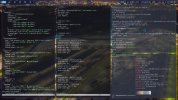Unfortunately, today I have Wayland on my second SSD as an experimental testing ground.
Considering the trends on this forum, I think that the Wayland ecosystem will not be actively promoted in the FreeBSD environment.
Yes, it works, something starts, there is good performance, but the software developers are in no hurry.
Adaptation of ready-made and primary products like LibreOffice is also very lame.
I think that we just need to abandon the concept of "bloat", as is customary in KDE Plasma.
Then, yes, there is a chance to get something that works well.
Unfortunately, I experienced in practice how deep this hole is.
Today, only KDE Neon has implemented the Wayland ecosystem better than anyone else. But this crap is impossible to use because of
systemd.
Ubuntu SwayRemik is worse. There are a lot of unfinished business + systemd again. SUSE and Fedora are better, but again, everything is the same: surveillance, interception of control over your PC, etc.
Rating 0.5/1 - this is my subjective assessment of the state of Wayland on FreeBSD today. Only 50% of the work has been done at best.
It is unlikely that anything progressive will happen in the near future.
Unless you fork Wayland, bring the basic software to a working state.
I read threads for 2012. For example, everything is still bad with your energy-saving modes, sleep, hypernations (especially on laptops).
It has not become radically better. Therefore, having FreeBSD on a laptop today is only a loss.
And closing the laptop lid, and then restoring the state through magic commands...
Guys, to hell with such progressive technologies.
This is just insanity. Or as someone here suggested increasing the speed of Wi-Fi by pushing drivers through layers of abstractions and virtualizations (there is such a topic, search for it if you are interested)...
For that, I would permanently block access to the Internet for such advisers.
Things are going badly everywhere so far. Even in Linux.
Here is a dialogue of a famous oldfag programmer Andrew Stolyarov (
translation):
Starting with Trixie 13, UsrMerge will be performed in Debian and Devuan. The directories /bin, /sbin and /lib will become symbolic links to /usr/bin, /usr/sbin and /usr/lib.
Is it time to leave Debian and its forks, or is it necessary, and Debian just can't keep up with Ubuntu/Arch/Fedora/openSUSE/Alpine/...?
It's high time to leave.
This is understandable

I asked the question to find out whether it is worth looking at distributions where this usr-merge has already been done. I do not have enough knowledge to understand for myself what this change actually affects, and the articles about it are exclusively laudatory.
I do not quite understand how this can be considered anything other than degradation.
The point is that /bin, /sbin and /lib are what the system cannot take off without, while /usr with everything under it is all kinds of application software.
For example, /usr can live on a network drive. And if the computer is completely diskless, it should usually have its own root, including /bin and /sbin, i.e. a copy is made from the network on the RAM disk, while /usr in all its huge mass is simply mounted.
In general, I don't know what kind of moral freaks pushed through this idiotic change and who do you have to be to praise it. A dumb newfag scum is a dumb newfag scum.
initramfs has no right to exist and never had any right to exist, as well as loadable kernel modules. The kernel should be monolithic and rebuilt with any change in the driver configuration, everything else is a lousy sieve. Another question is that once the kernel was built in half an hour on an i386 with eight, or something, megabytes of RAM, and now you can't build it in any acceptable time on all these multi-core atmosphere heaters.
Progress, damn it.

